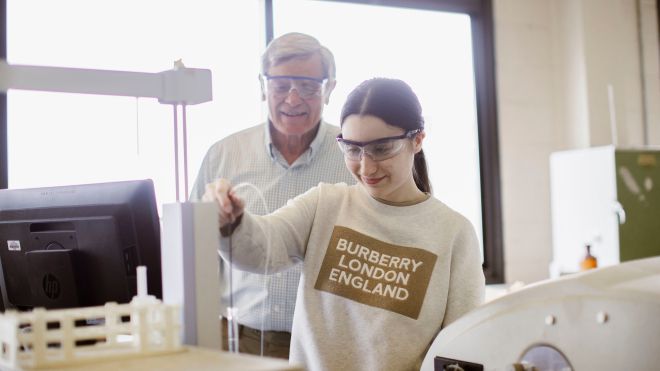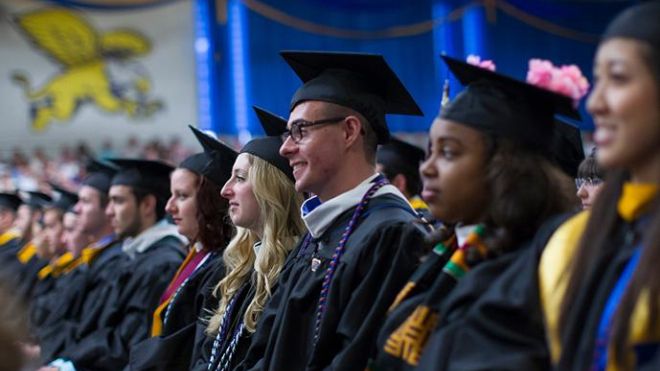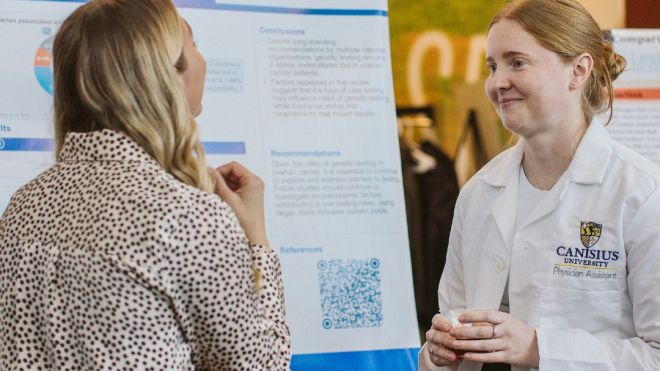Courtney Hatten ’14 slowly nods her head as a look of astonishment washes over her face. The computer science major is standing in the sunlit atrium of Science Hall, where she now spends most of her time. It’s a drastic change from the space that used to house the Computer Science Department.
“When you think about computer science – any science really – what comes to mind is what you see here: sleek, bright, new, high-tech,” says Hatten. “There’s definitely an ‘awe’ factor going on.’”
Science Hall officially opened in August and the feedback among the campus community is unanimous: It’s a world-class science facility fit for the college’s world-class science programs.
“We look at this project as doubling, tripling even, our investment in what has been a very strong program for Canisius,” says President John J. Hurley. “It is absolutely essential if we are going to continue to perform at that high, national impact level with our science programs.”
WORLD-CLASS COMPLEX
Phase 1 of Science Hall is an impressive 120,000 square feet of space now home to the departments of Computer Science and Mathematics, the Institute for Autism Research (IAR) and the Dr. George E. Schreiner Pre-Medical Center. (Subsequent phases will welcome the departments of Physics, Chemistry, Biochemistry, Biology and the Institute for the Study of Human-Animal Relationships.) In addition to faculty offices, conference and seminar rooms, the first level of Science Hall includes teaching labs, computer labs, robotics and physics/electronics labs – all equipped with technology as sophisticated as the facility that houses it. But Science Hall’s most vital resource is the dedicated real estate it provides for departments to develop and grow their programs.
“We now have a central place to conduct treatments, assessments and evaluations of individuals with autism spectrum disorders,” says Christopher J. Lopata, PsyD, co-director of the Institute for Autism Research (IAR). He and IAR Co-Director Marcus L. Thomeer, PhD, previously conducted their research wherever they could find available rooms on campus. That meant they had to reserve space well in advance, and haul their computers, cameras and materials to those different locations.
With a permanent home in Science Hall, the IAR will now develop, implement and evaluate research initiatives year-round. Its new facilities include six dedicated treatment rooms, three adjoining observation rooms, and a research-in-training room outfitted with the technology needed to assess the cognitive, social and emotional functions of individuals with autism spectrum disorders.
“We can significantly expand the scientific learning experiences and academic programming opportunities for undergraduate and graduate students, and conduct even more innovative research and treatment programs,” says Thomeer. “The result will make Canisius a leading center for training on autism spectrum disorders, public outreach and research dissemination.”
Of course, Science Hall is about more than the space it provides to develop and grow programs. It’s a discovery zone, where teaching, research and innovation not only come together but come alive.
“We can no longer think of science in traditional silos - just chemistry, just biology or just physics, for example” says David W. Ewing, PhD, dean of the College of Arts and Sciences. “The sequencing of genomes, life-saving advances in medicine or the development of clean, new sources of energy will not spring from individuals who work in isolation but from teams of scientists, from different disciplines, who look at the same problem in different ways to move research forward.”
This new approach to science requires biologists, chemists, computer scientists, engineers, mathematicians and physicists to share their knowledge. In order to do so, they must speak each other’s languages and be trained to think as interdisciplinary scientists. At Canisius, that training begins the moment students enter Science Hall.
A striking four-story living green wall serves as a visual reminder that science and nature are infinitely intertwined. Glass walls and walkways throughout are windows to science-in-action. Science is on display in the Margaret L. Wendt Animal Behavior Laboratory. Housed in the Science Hall atrium, this year-round integrated and interactive space showcases faculty and student exhibits, curated in cooperation with the Buffalo Museum of Science and the Buffalo Zoo. The science-on-display laboratory will also house the Canisius Zoological Society’s mini-zoo, developed biennially.
Students are also likely to encounter special events or department demonstrations while in the vast atrium of Science Hall. Associate Professor of Computer Science Debra T. Burhans, PhD, plans to make use of the first level’s open floor plan to showcase her students’ robotics innovations.
“Maybe students heard about our programs when we were in the Wehle Technology Center but no one ever saw what we do because there’s no foot traffic in that building,” says Burhans. “There is such a high volume of traffic that goes through Science Hall every day that it provides us a great opportunity to showcase our robots and expose people to all the terrific things we do in computer science.”
That traffic includes more than traditional science students.
Science Hall hosts economics, finance and accounting students, all of whom have math classes in the building. Math and science education majors utilize Science Hall’s teaching labs to train for their classroom experiences. Science Hall is also a resource for business students exploring ways to bring discoveries to market.
“One of the most amazing things about Science Hall is that no matter who walks through the facility, they can see exactly what the sciences are all about at Canisius, and what students and faculty are doing together,” says Sara R. Morris, PhD, professor of biology.
WORLD-CLASS DISCOVERY
Science Hall’s infrastructure is designed to break down barriers between traditional disciplines. But it is the extent to which students and professors can now learn, study and socialize collaboratively that will ultimately give rise to new knowledge and accelerate discoveries.
Gone are the traditional laboratories, with their long, solitary, forward-facing rows. Rather, island workstations cluster young investigators together to forge new breakthroughs. The research-rich complex is also home to sophisticated instructional technologies that enable Canisius explorers to connect and collaborate with their peers off campus. And you won’t find conventional lecture halls here. Instead, Science Hall houses teaching laboratories. Outfitted with flexible furniture and state-of-the-art technology, these modern day classrooms make it possible for faculty to customize the space to support interdisciplinary curriculum needs.
“I used to have to try to make my teaching needs fit my given classroom,” says Dietrich W. Kuhlmann, PhD, chair of mathematics and statistics. “Now I’m changing the way I teach to take advantage of all the great resources available in Science Hall.”
“You can’t help but begin to think and interact differently when you move into a kind of facility like Science Hall,” adds an energized Burhans, whose students already collaborate on research with biology and physics students.
Of course, the college’s science programs have long garnered national recognition for their successes. Even with departments scattered across campus, Canisius ranked fourth in chemistry, ninth in physics, and among the top 15 in the life sciences and mathematics among comprehensive universities. “But just imagine the potential with all the sciences under the same roof,” says Richard A. Wall, PhD, interim vice president for academic affairs.
Envision a vast increase in the number of students engaged in research. Expect more scientific discoveries born from faculty-student pioneers engaged in exciting new collaborations. Look for the quality of research to improve and along with that, a greater number of students co-authoring publications in peer-reviewed journals or presenting at national and international conferences.
“Science Hall builds upon one of the greatest strengths of the Canisius science
program, which is the opportunity for students to learn and work side-by-side with faculty,” says Morris. “That is what will attract more students to the program, enable us to maintain our superior placement rates for graduate, doctoral and professional candidates, and ultimately keep Canisius at the forefront of undergraduate science education and research.”
AN INCUBATOR FOR THE FUTURE
In addition to serving as a hub for new curricular and research initiatives at Canisius, Science Hall similarly serves as an incubator for the world-class research underway in Western New York’s burgeoning life sciences industry.
“Just as we are creating a world-class medical facility in downtown Buffalo, it is exciting that Canisius is creating a world-class undergraduate science learning center just a few blocks away,” says Matthew K. Enstice MBA ’04, president and executive director of the Buffalo Niagara Medical Campus and member of the college’s Science Advisory Council.
Science Hall enables faculty to deepen their relationships with colleagues at the Buffalo Niagara Medical Campus. Undergraduate students can engage in more research internships at Roswell Park Cancer Institute and Hauptman-Woodward Institute, where Canisius already has a record of achievement. Graduates will be top candidates for advanced degree programs and leading contenders for employment across all aspects of medicine and life sciences.
“What is most exciting to me is that Canisius now has more resources to provide students with an even more outstanding education in the sciences,” says Catherine M. Burzik ’72, chair of the Canisius University Board of Trustees and former president and CEO of Kinetic Concepts Inc. “The fundamentals I received in mathematics and the sciences at Canisius helped me through my entire career. I believe Science Hall will have the same benefit on the education of future students in the sciences.”
UNFINISHED BUSINESS
Still, there is some unfinished business with regards to Science Hall.
The Legacy of Leadership campaign, which concluded May 31 (Canisius Magazine, summer 2012) secured significant support for the purchase of the building and the renovation of its first level. Additional support is needed to renovate the subsequent levels of Science Hall, and develop it into an inspirational building that reflects the quality and character of the entire college.
When this is realized, Canisius University will be home to a signature interdisciplinary science complex, one that defines a new standard for science at Catholic, Jesuit institutions; yields new knowledge and discoveries; attracts new researchers with great ambitions to solve health, environmental or technological challenges; and is a magnet for the next and most talented generation of students in the nation.
“It’s a place to not just study science but to become immersed in it,” says Courtney Hatten who considers Science Hall her home-away-from-home, at least for the next two years.



